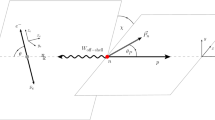Abstract
A theory of nuclear \(2{\beta }\)decay that includes \(2{{{\beta }}^{ - }}\), \(2{{{\beta }}^{ + }}\), \({{{\beta }}^{ + }},EC\), and \(EC,EC\)decays is constructed using results obtained in developing the theory of the two-proton decay of nuclei. The existence of two types of these decays is established. The first type corresponds to \(2{\beta }\) decays that proceed via two sequential real \({\beta }\) decays of a parent nucleus and the compound nucleus generating from the parent nucleus. The second type is associated with the virtual nature of \(2{\beta }\)decays, the widths of which are described by formulas similar to the ones obtained earlier in the second order of perturbation theory in the Hamiltonian of weak interaction. The possibility is demonstrated of successfully describing experimental characteristics of the \(2{\beta }\)decay for a wide range of nuclei.

Similar content being viewed by others
REFERENCES
Fermi, E., Z. Phys., 1934, vol. 88, p. 161.
Suhonen, J. and Civitarese, O., Phys. Rep., 1998, vol. 300, p. 123.
Tretyak, V.I., Double Beta-Decay: History and Current Status, vol. 58, Kiyv: Inst. Nucl. Res., 2014.
Goeppert-Mayer, M., Phys. Rev., 1935, vol. 48, p. 512.
Inghram, M.G. and Reynolds, J.H., Phys. Rev., 1950, vol. 78, p. 822.
Sliv, L.A., Zh. Eksp. Tekh. Fiz., 1950, vol. 20, p. 1035.
Landau, L.D. and Lifshits, B.N., Kvantovaya mekhanika. Nerelyativistskaya teoriya (Quantum Mechanics: Non-Relativistic Theory), Moscow: Nauka, 1974.
Kadmensky, S.G. and Ivankov, Yu.V., Phys. At. Nucl., 2014, vol. 77, p. 1019.
Kadmensky, S.G. and Ivankov, Yu.V., Phys. At. Nucl., 2014, vol. 77, p. 1532.
Kadmensky, S.G., Ivankov, Yu.V., and Lyubashevsky, D.E., Phys. At. Nucl., 2017, vol. 80, p. 903.
Gol’danskii, V.I., Zh. Eksp. Tekh. Fiz., 1960, vol. 39, p. 497.
Gol’danskii, V.I., Sov. Phys. Usp., 1966, vol. 8, p. 770.
Solov’ev, V.G., Teoriya atomnogo yadra: Yadernye modeli (Atomic Nuclear Theory: Nuclear Models), Moscow: Energoatomizdat, 1981.
Ishkhanov, B.S., Radioaktivnost’ (Radioactivity), Moscow: Universitetskaya Kniga, 2011.
Live Chart of Nuclides. https://www-nds.iaea.Org/relnsd/vcharthtml/VChartHTML.html.
Nuclear Wallet Cards Search. www.nndc.bnl.gov/nudat2/indx_sigma.jsp.
WWW Table of Radioactive Isotopes: Nuclide search. http://nucleardata.nuclear.lu.se/toi/nucSearch.asp.
Data Center for Photonuclear Experiments. http://cdfe.sinp.msu.ru/services/gsp.ru.html.
Author information
Authors and Affiliations
Corresponding author
Additional information
Translated by I. Obrezanova
About this article
Cite this article
Lubashevsky, D.E. Virtual Double Beta Decays of Nuclei. Bull. Russ. Acad. Sci. Phys. 84, 1201–1206 (2020). https://doi.org/10.3103/S1062873820100160
Received:
Revised:
Accepted:
Published:
Issue Date:
DOI: https://doi.org/10.3103/S1062873820100160




